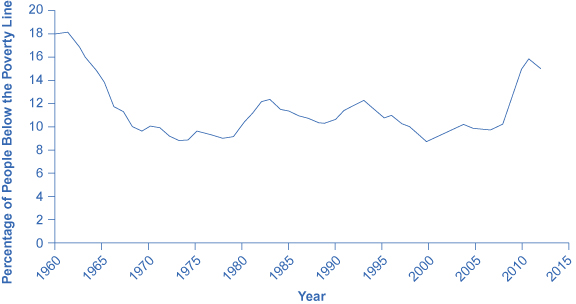| << Chapter < Page | Chapter >> Page > |

| Group | Poverty Rate |
|---|---|
| Females | 15.8% |
| Males | 13.1% |
| White | 9.6% |
| Black | 27.1% |
| Hispanic | 23.5% |
| Under age 18 | 19.9% |
| Ages 18–24 | 20.6% |
| Ages 25–34 | 15.9% |
| Ages 35–44 | 12.2% |
| Ages 45–54 | 10.9% |
| Ages 55–59 | 10.7% |
| Ages 60–64 | 10.8% |
| Ages 65 and older | 9.5% |
The concept of a poverty line raises many tricky questions. In a vast country like the United States, should there be a national poverty line? After all, according to the Federal Register, the median household income for a family of four was $102,552 in New Jersey and $57,132 in Mississippi in 2013, and prices of some basic goods like housing are quite different between states. The poverty line is based on cash income, which means it does not take into account government programs that provide assistance to the poor in a non-cash form, like Medicaid (health care for low-income individuals and families) and food aid. Also, low-income families can qualify for federal housing assistance. (These and other government aid programs will be discussed in detail later in this chapter.)
Should the poverty line be adjusted to take the value of such programs into account? Many economists and policymakers wonder whether the concept of what poverty means in the twenty-first century should be rethought. The following Clear It Up feature explains the poverty lines set by the World Bank for low-income countries around the world.
The World Bank sets two poverty lines for low-income countries around the world. One poverty line is set at an income of $1.25/day per person; the other is at $2/day. By comparison, the U.S. 2015 poverty line of $20,090 annually for a family of three works out to $18.35 per person per day.
Clearly, many people around the world are far poorer than Americans, as [link] shows. China and India both have more than a billion people; Nigeria is the most populous country in Africa; and Egypt is the most populous country in the Middle East. In all four of those countries, in the mid-2000s, a substantial share of the population subsisted on less than $2/day. Indeed, about half the world lives on less than $2.50 a day, and 80 percent of the world lives on less than $10 per day. (Of course, the cost of food, clothing, and shelter in those countries can be very different from those costs in the United States, so the $2 and $2.50 figures may mean greater purchasing power than they would in the United States.)
| Country | Share of Population below $1.25/Day | Share of Population below $2.00/Day |
|---|---|---|
| Brazil (in 2009) | 6.1% | 10.8% |
| China (in 2009) | 11.8% | 27.2% |
| Egypt (in 2008) | 1.7% | 15.4% |
| India (in 2010) | 32.7% | 68.8% |
| Mexico (in 2010) | 0.7% | 4.5% |
| Nigeria (in 2010) | 68.0% | 84.5% |

Notification Switch
Would you like to follow the 'Principles of economics' conversation and receive update notifications?